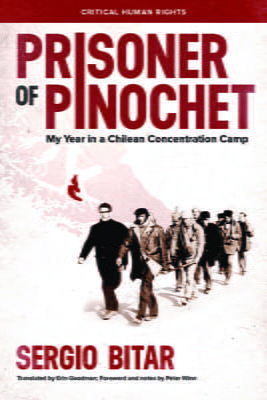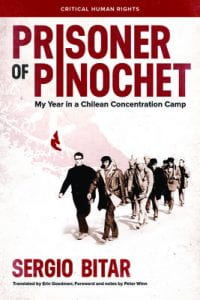A Review of Prisoner of Pinochet: My Year in a Chilean Concentration Camp

Prisoner of Pinochet: My Year in a Chilean Concentration Camp Sergio Bitar, translated by Erin Goodman with foreword and notes by Peter Winn Madison: University of Wisconsin Press, 2017
On September 11, 1973, at about eight o’clock in the morning, Sergio Bitar, one of Allende’s top economic advisers and the Minister of Mining, received a phone call from a colleague: the military was on the move. Downtown Santiago was surrounded by soldiers. It had to be the coup they’d been expecting. Bitar’s first thoughts were “diffuse.” Since Chile’s constitutionalist military had neutralized previous coup attempts, he prepared to head downtown himself for a meeting he had scheduled with CORFO, the agency that managed the public economy and had nationalized the country’s major industries. But then, the one radio station still functioning announced that the military was bombing the presidential palace La Moneda. As his middle-class neighbors cheered the fall of the socialist Popular Unity government, Bitar and his wife gathered their children to take them to a place of greater safety.
As the family drove away from their home, news reports confirmed that the coup was unstoppable.
Bitar recounts his experiences in this 1987 book, translated for the first time into English, in an even tone: from the moment of his capture, he clearly made a pact with himself to stay alert, observant, lucid and mentally organized. He kept track, as best he could, of dates, knowing that timekeeping is especially hard for those in captivity.
But that’s getting ahead of the story. That fateful September 11, war planes were bombing radio stations, flying low above the city streets to intensify the terror. Radio Magallanes broadcast Allende’s courageous and devastating last words, then went off the air. Bitar had long known that Allende would die by his own hand rather than let himself be slaughtered by the enemies of democracy. The legitimately elected socialist president wanted, more than anything, to save his country from civil war.
With his regime long under threat, Allende had instructed his Cabinet to secure safe houses in the event of dire emergency. Bitar drove to the modest neighborhood of La Florida where a woman who had worked for his mother and known him as a child would shelter him. A day later, Bitar was ordered via radio broadcast to report to the Ministry of Defense. Although he had offers of asylum from several embassies, Bitar refused to flee; Allende’s surviving Cabinet members, congressional representatives and political leaders had all got the same order. Some of these men had, like Bitar, left their safe houses; others had remained at the presidential palace during the bombing and since their capture had been held incommunicado. The reunion (if that’s the word) was emotional: they were relieved to see dear comrades alive, but were also anxious and frightened, especially for their families.
From September 12, 1973, until October 28, 1974, Bitar was a political prisoner (renamed Isla 10 by his captors) in Antarctica. The body of his narrative is preceded by a complete list of the forty-seven Unidad Popular Prisoners held at Dawson Island—Cabinet members, government ministers, congressional representatives, senators, mayors, party and union leaders, a university president, the director of the national bank, Allende’s personal physician and press secretary. Among these men (they were all men), was Orlando Letelier, who served, successively, as Allende’s Minister of Foreign Affairs, Interior, and Defense, and who would be assassinated by an agent of Pinochet’s secret service in September 1976, in Washington, D.C.
Located in the Strait of Magellan in the Tierra del Fuego archipelago, Dawson Island has a long history as an internment camp. Inhabited for thousands of years by the Selknam and other indigenous tribes, it was seized in the 19th century by European settlers, miners, gold-diggers and bounty hunters who corralled the local Indians after taking their lands, dwellings and animals. After the Selknam genocide, the island was given to Salesian missionaries who were to oversee the “assimilation” of the surviving Selknam and their descendants. Dawson Island again became a site of human rights abuses when within days of the coup, the Chilean armed forces commandeered the island and ran it as a concentration camp for Allende’s inner circle and prominent supporters.
In freezing temperatures, driving rains and deep mud, Bitar and his companions were subjected to forced labor (cutting down trees, sawing logs, sinking fences), insufficient and disgusting rations, inadequate sanitation, and uniforms and bedding grotesquely unsuited to Antarctic conditions. Prisoners got badly injured; several died. Some got so sick they would be ill for the rest of their lives. Torments included ear-splitting sirens and light storms in the middle of the night. Interrogations sometimes included outright torture (though not in Bitar’s case). The group could be suddenly moved to other locations—furious roundups, a storm of trucks, unexplained transport to another bare-bones and brutal camp, as he vividly recounts.
Bitar’s narrative, though personal, is at its heart communal. He keeps track of the men around him, documenting illnesses and injuries, moods and modes of coping. Not a page goes by without clear descriptions of canny strategies for surviving at the bottom of the world. The mutual generosity of these men may have been their best protection against the daily humiliations and cruelties of their captors. Whenever one of their group gets a letter (though heavily redacted), a package (always previously opened and often pilfered), a visit, or is released, Bitar never fails to say, “Good news for one of us was good news for all.” And he recounts how the mood in the barracks would then lift, the pace of activity pick up.
The prisoners held classes and formed study groups. In their number were international experts in economics, political science, history, the military and a host of other academic disciplines. Smaller groups studied languages. Bitar taught German, and with the skillset of a Harvard-trained economist, he began a rigorous analysis of Allende’s government programs, focusing particularly on what they could have done, or explained, better. (Bitar would go on to write a number of important books on Chilean democracy, economy and military.) The group jerry-rigged a radio, but this too could be a source of misery, as when the regime triumphantly broadcast the deaths of comrades (“enemies of the state”).
As Bitar makes clear, triumphalism was not universally shared among the captors on Dawson Island. The highest-ranking officers tended to be true believers in the cause to eradicate socialism; the lower ranks were more mixed—a number of soldiers and policemen posted to Dawson Island had been in Allende’s Popular Unity party or in other leftist organizations, and had their own apprehensions. Even some of Pinochet’s most ardent supporters treated Bitar and his group as Prisoners of War—a misnomer (there was no war, it was an unopposed military coup), but the so-called status granted the prisoners certain rights and gave the captors a cleansing sense of mission. That these attitudes were simultaneously in play further complicated the prisoners’ situation. Speculation and rumor, conflicting statements, attitudes and information intensified the prisoners’ anxieties.
Included in this volume are a suite of affecting photographs: Bitar and fellow cabinet member Jorge Tapia reporting to the Escuela Militar two days after the coup; a censored page of a letter from Bitar’s wife, Kenny; prisoner portraits and camp drawings by fellow prisoner Miguel Lawner (Director of the Corporation for Urban Improvement); a photo of bundled-up prisoners trudging back to camp after work; Bitar’s lovely stone carvings done to pass the time. One of the most moving photographs shows Las Dawsonianas, as the prisoners’ activist wives called themselves. The picture shows five of these vibrant women sitting close together on a living room sofa with Allende’s widow, Hortensia, front and center. Two of these women (Margarita Morel de Letelier and Moy Morales de Toha) would later also lose their husbands.
International pressure was key to the prisoners’ survival, liberation and offers of asylum. Sergio Bitar left Chile on November 14, 1973, for Washington, D.C., where he was awaited by the friends who’d won his freedom and who now urged him to “write down everything you’re telling [us].” While teaching at Harvard in 1975, Bitar spent time each day systematically dictating his prison story into a tape recorder. His wife, Kenny Hirmas de Bitar, transcribed every word, archived every page, and kept the manuscript safely hidden away for nine years. In 1984, Bitar was allowed to return to Chile, where the book was published in 1987, while Pinochet was still in power. Printed multiple times in Chile and translated into at least a score of languages, Prisoner of Pinochet only now appears in English. That is a whole other cultural story, and a disheartening one, in view of Bitar’s distinguished profile as a scholar and political leader in post-Pinochet Chile.
But let us take this publication for the belated triumph that it is. Erin Goodman’s translation hews to the grounded, modest tone of Bitar’s Spanish. Peter Winn supplied excellent notes, and his foreword is at once personal, surpassingly lucid and eloquent. As a young man in Santiago, Winn found himself in the plaza as the military bombed La Moneda. It was a moment that would change his life, and help produce one of the finest Latin Americanists of his generation.
A final word of praise for Steve Stern and Scott Strauss, who direct the Critical Human Rights series at the UW Press. Theirs is a distiguished list of titles, and Bitar—aways one to value good company—is right at home.
Un Cuento de Sobreviviente

Dawson isla 10. Prisionero de Pinochet: mi año en un campo de concentración chileno por Sergio Bitar, traducido por Erin Goodman y con prólogo y notas de Peter Winn (Madison: Universidad de Wisconsin Press, 2017)
Reseña de Marguerite Feitlowitz, Traducción de Mariana C. Irazu
El 11 de septiembre de 1973, a eso de las ocho de la mañana, Sergio Bitar, uno de los principales asesores económicos de Allende y el Ministro de Minería del momento, recibe una llamada telefónica de un colega: el ejército se estaba movilizando. El centro de Santiago estaba rodeado de soldados. El golpe que habían estado esperando había llegado. Los primeros pensamientos de Bitar fueron “difusos”. Ya que los militares constitucionalistas de Chile habían neutralizado intentos de golpe anteriores, se preparó para dirigirse al centro para una reunión que había programado con CORFO, la agencia que administraba la economía pública y había nacionalizado las principales industrias del país. Sin embargo, la única estación de radio que se mantenía en funcionamiento anunció que los militares estaban bombardeando el palacio presidencial La Moneda. Así, mientras sus vecinos de clase media aplaudían la caída del gobierno socialista de la Unidad Popular, Bitar y su esposa reunieron a sus hijos para llevarlos a un lugar de mayor seguridad.
Mientras la familia se alejaba de su casa, las noticias confirmaron que el golpe no pudo ser detenido.
Bitar relata sus experiencias en este libro, publicado originalmente en 1987 y ahora traducido por primera vez al inglés, en un tono compuesto: desde el momento de su captura, hizo un pacto consigo mismo para mantenerse alerta, observador, lúcido y con su mente despejada. Hizo su mejor esfuerzo para mantener un registro de las fechas, sabiendo que tal cronometraje es particularmente difícil para quienes están en cautiverio.
Pero ya eso es adelantarse a la historia. Ese fatídico 11 de septiembre, los aviones de guerra bombardearon las estaciones de radio y volaron a baja altura sobre las calles de la ciudad para intensificar el terror. Radio Magallanes transmitió las valientes y devastadoras últimas palabras de Allende, saliendo inmediatamente del aire. Bitar sabía desde hacía mucho tiempo que Allende moriría por su propia cuenta, no se dejaría asesinar por los enemigos de la democracia. El presidente socialista legítimo quería, más que nada, salvar a su país de una guerra civil.
El régimen de Allende ya tenía mucho tiempo bajo amenaza, por lo que el presidente había ordenado a su gabinete asegurar algún refugio que pudieran acceder en caso de una emergencia extrema. Bitar condujo hasta La Florida, un barrio modesto. Ahí, una mujer que había trabajado para su madre y que lo conocía desde niño lo protegería. Un día después, Bitar recibió una orden vía radio de presentarse ante el Ministerio de Defensa. A pesar de haber recibido ofertas de asilo de varias embajadas, Bitar se negó a huir; los sobrevivientes del gabinete de Allende, representantes del Congreso y líderes políticos tenían todos la misma orden. Algunos de ellos, como Bitar, habían abandonado sus refugios; otros se habían quedado en el palacio presidencial durante el bombardeo y permanecido incomunicados desde su captura. La reunión (si así se le puede llamar) fue muy emotiva: se sintieron aliviados de ver a sus queridos compañeros vivos, pero también estaban ansiosos y aterrados, especialmente por sus familias.
Desde el día 12 de septiembre de 1973 hasta el 28 de octubre de 1974, Bitar fue un prisionero político en la Antártida (bautizada Isla 10 por sus captores). El cuerpo de su relato está precedido por una lista completa de los cuarenta y siete prisioneros de la Unidad Popular que estuvieron detenidos en la isla Dawson: miembros del gabinete, ministros del gobierno, representantes del Congreso, senadores, alcaldes, líderes sindicales, un presidente universitario, el director del Banco Nacional, el médico personal de Allende y su secretario de prensa. Entre estos hombres (todos eran hombres), estaba Orlando Letelier, quién había servido, sucesivamente, como Ministro de Asuntos Exteriores, Interior y Defensa de Allende. Letelier sería asesinado por un agente del servicio secreto de Pinochet en septiembre de 1976, en Washington DC.
Ubicada en el Estrecho de Magallanes en el archipiélago de Tierra del Fuego, la isla Dawson tiene una larga historia como campo de internamiento. Fue habitada durante miles de años por los Selknam y otras tribus indígenas. En el siglo XIX fue capturado por colonizadores europeos, mineros, cazafortunas y cazadores de recompensas que acorralaron a los indios locales después de tomar sus tierras, viviendas y animales. Después del genocidio de los Selknam, la isla fue entregada a misioneros salesianos que debían supervisar la “integración” de los Selknam que sobrevivieron y de sus descendientes. La isla Dawson, una vez más se convirtió en un espacio de violación de los derechos humanos cuando días después del golpe, las fuerzas armadas chilenas tomaron el mando de la isla y optaron por dirigirla como un campo de concentración para el círculo interno de Allende y sus seguidores prominentes.
Con temperaturas bajo cero, lluvias torrenciales y barro profundo, Bitar y sus compañeros fueron sometidos a trabajos forzosos (talar árboles, aserrar troncos, hundir cercas). Las raciones eran pocas y desagradables, las condiciones sanitarias eran inadecuadas, los uniformes y ropa de cama grotescamente insuficiente para las condiciones antárticas. Hubo heridas graves; varios prisioneros murieron. Algunos se enfermaron tanto que pasarían el resto de sus vidas enfermos. Para atormentarlos, utilizaban sirenas desgarradoras y tormentas de luz a media noche. Los interrogatorios llegaban al punto de tortura (aunque nunca en el caso de Bitar). El grupo podía ser trasladado repentinamente, sin explicación, a otro campamento: redadas, masas de camiones, en forma brutal y estado de desnudez, como lo recuerda vívidamente.
La narrativa de Bitar, aunque redactada desde lo personal, pertenece al colectivo en su corazón. Él mantuvo los récords de los hombres a su alrededor, documentando sus enfermedades y lesiones, estados de ánimo y tipos de afrontamiento. No pasa una página sin incluir descripciones claras de las astutas estrategias que implementaban para sobrevivir en la base del mundo. La generosidad mutua de estos hombres puede haber sido su mejor protección contra las humillaciones y crueldades de sus captores. Cada vez que uno del grupo recibe una carta (redactada con mucha delicadeza), un paquete (siempre abierto previamente y, a menudo, saqueado), una visita, o es liberado, Bitar reafirma: “Las buenas noticias para uno eran buenas noticias para todos”. Cuenta cómo el estado de ánimo en el cuartel se levantaba y el ritmo de actividades aumentaba.
Los prisioneros instauraron clases y formaron grupos de estudio. Entre ellos había expertos internacionales en economía, ciencias políticas, historia, milicia y una serie de otras disciplinas académicas. En grupos más pequeños estudiaron idiomas. Bitar enseñó alemán, y con el conjunto de habilidades de un Economista entrenado en Harvard, comenzó un análisis riguroso de los programas gubernamentales de Allende, centrándose particularmente en lo que podrían haber hecho, o explicado, mejor. (Bitar escribiría una serie de libros importantes sobre democracia, economía y militares chilenos.) El grupo aparejó una radio, pero esto también podía ser una fuente de miseria, como cuando el régimen triunfante transmitía las muertes de sus camaradas (“los enemigos del estado”).
Bitar deja en claro que el triunfalismo no fue universalmente compartido entre los captores de la isla Dawson. Los oficiales de más alto rango tendían a ser verdaderos creyentes en la causa de erradicar al socialismo; los de rangos inferiores eran menos uniformes: algunos de los soldados y policías enviados a la isla Dawson habían estado en el partido de la Unidad Popular de Allende o en otras organizaciones de izquierda, y tenían sus propias aprehensiones. Algunos de los partidarios más ardientes de Pinochet denominaron a Bitar y a su grupo como prisioneros de guerra, un nombre inapropiado (no hubo guerra, fue un golpe de estado sin oposición), pero dicho nombre le otorgó a los prisioneros ciertos derechos y les dio a los secuestradores un sentido de coherencia a la misión. Estas actitudes en juego complicaban aún más la situación de los prisioneros. La especulación, los rumores, las declaraciones inconsistentes y la ausencia de información clara, fueron factores que intensificaron las ansiedades de los presos.
Se incluyen en este volumen un conjunto de fotografías: Bitar y su compañero de gabinete Jorge Tapia reportándose a la Escuela Militar dos días después del golpe; una página censurada de una carta de la esposa de Bitar, Kenny; retratos de presos y dibujos de campamentos hechos por el prisionero Miguel Lawner (Director de la Corporación para la Mejora Urbana); una foto de un grupo de prisioneros arropados que regresan fatigosamente al campamento después del trabajo; las hermosas tallas de piedra de Bitar, hechas para pasar el tiempo. Una de las fotografías más conmovedoras muestra a “Las Dawsonianas”, como se hacían llamar las esposas activistas de los prisioneros. La imagen muestra a cinco de estas mujeres vibrantes sentadas una muy cerca de la otra en un sofá de la sala de Allende, con su viuda, Hortensia, al frente y centro. Dos de estas mujeres (Margarita Morel de Letelier y Moy Morales de Toha) más tarde también perderían a sus maridos.
La presión internacional era clave para la supervivencia, liberación y la oferta de asilo de los presos. Sergio Bitar salió de Chile el 14 de noviembre de 1973 para Washington, D.C., donde lo esperaban los amigos que ganaron su libertad y que ahora le urgían: “escribe todo lo que nos estás diciendo”. Mientras enseñaba en Harvard en 1975, Bitar pasó un período en el que cada día, sistemáticamente dictaba su historia penitenciaria en una grabadora. Su esposa, Kenny Hirmas de Bitar, transcribió cada palabra, archivó cada página, y guardó el manuscrito a salvo, escondido durante nueve años. En 1984, Bitar pudo regresar a Chile, donde el libro se publicó en 1987, mientras Pinochet todavía seguía instaurado. Impreso varias veces en Chile y traducido a al menos una veintena de idiomas, el Dawson isla 10 sólo ahora aparece en inglés. Ese otro relato cultural es, uno muy desgarrador, considerando el distinguido perfil de Bitar como erudito y líder político en Chile post-Pinochet.
Pero tomemos esta publicación como el triunfo tardío que es. La traducción de Erin Goodman se adhiere al tono modesto y arraigado de Bitar en castellano. Peter Winn proporcionó excelentes notas, y su prólogo es personal, y a la vez destacadamente lúcido y elocuente. Cuando era un hombre joven en Santiago, Winn se encontraba en la plaza cuando los militares bombardearon La Moneda. Fue un momento que cambiaría su vida y ayudaría a producir uno de los mejores latinoamericanistas de su generación.
Una última palabra de elogio para Steve Stern y Scott Strauss, quienes dirigen la serie Crítica de Derechos Humanos (Critical Human Rights) en la prensa de la Universidad de Wisconsin (UW Press). La suya es una lista distinguida de títulos, y Bitar, que siempre sabe valorar la buena compañía, está en casa.
Spring/Summer 2018, Volume XVII, Number 3
Marguerite Feitlowitz is the author of A Lexicon of Terror: Argentina and the Legacies of Torture. She teaches at Bennington College in Bennington, Vermont.
Marguerite Feitlowitz es la autora de “A Lexicon of Terror: Argentina and the Legacies of Torture”, es profesora en Bennington College en Bennington, Vermont.
Traducido al castellano por Mariana C. Irazu.
Mariana C. Irazu es venezolana, su trabajo ha sido publicado por medios como BBC Mundo. Actualmente estudia Ciencias Políticas y Periodismo en Bennington College, Vermont.
Related Articles
Words that Matter
Those of us with little children often read The Lorax by Dr. Seuss to them at bedtime. The story points toward the past, because the Lorax is a ruin, with only residues remaining of something…
One Long Night: A Global History of Concentration Camps
English + Español
In One Long Night: A Global History of Concentration Camps, Andrea Pitzer offers a thoughtful combination of investigative journalism and historical analysis that identifies the roots and
The Brave New World of the Digital Herbarium
Here in the northeast of the United States, spring will soon be upon us, pulling us from the darkness and cold of winter’s grip. Spring’s exuberance—singing and nesting birds returning from




